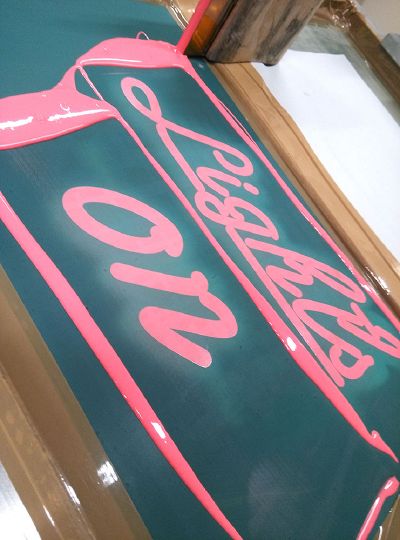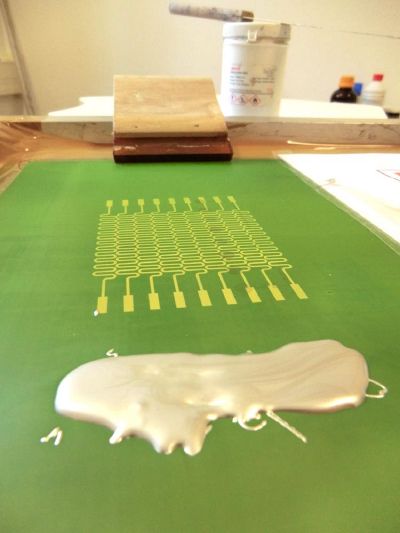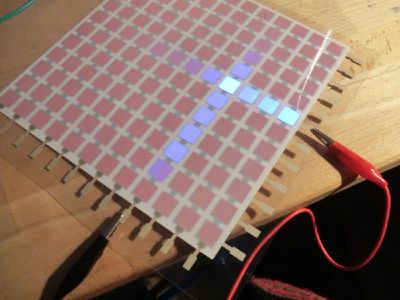No edit summary |
No edit summary |
||
| Line 1: | Line 1: | ||
[[:Category:Fachmodul|Fachmodul]]<br /> | [[:Category:Fachmodul|Fachmodul]], [[:Category:Fachmodul|Werkmodul]]<br /> | ||
''Title:'' Printed Electronics: Squeegee, brush, and multimeter <br /> | ''Title:'' Printed Electronics: Squeegee, brush, and multimeter <br /> | ||
''Lecturer:'' Florian Wittig<br /> | ''Lecturer:'' Florian Wittig<br /> | ||
Revision as of 07:42, 12 October 2016
Fachmodul, Werkmodul
Title: Printed Electronics: Squeegee, brush, and multimeter
Lecturer: Florian Wittig
Credits/SWS: 6 ECTS, 2 SWS
Maximum Number of Participants: 15
Course Language: English
First meeting: October 18, 17:00, Marienstraße 7b, Room 103
Date: Tuesdays, 17:00 until 18:30 h
Venue: Marienstraße 7b, Rooms 103 and 002
Description
This course focuses on the differences between technically precise screen printing, as it is used for printing electric circuits, and screen printing as an artistic technique. What are possibilities for combining the two?
We will talk about the basics of printing technology focusing on silk screen printing and discuss the different possibilities of printed electric circuits. Together we will test the conductivity of different inks and learn about the process and the tools for screen printing (this is not a substitute for the introduction courses of the university's print workshop, as we focus on printed electronics!). We might mix and test our own conductive ink as well.
Possibly we will have the chance to work with an independent screen print workshop to discuss the differences between the two workshops and the possibilities which the two different approaches offer. At the end of the course students will fabricate their own graphic product using screen printing and printed electronics.
Kursinhalt
In diesem Kurs beschäftigen wir uns mit den Unterschieden und Kombinationsmöglichkeiten zwischen technisch exaktem Siebdruck, wie man ihn zum Aufbringen von Leiterbahnen benutzt, und dem Siebdruck als künstlerischer Technik.
Wir befassen uns zunächst mit den Grundlagen der Druckverfahren mit Schwerpunkt auf der Siebdrucktechnik und diskutieren die Möglichkeiten gedruckter Schaltkreise. Wir testen die Leitfähigkeit verschiedener Druckfarben mit selbst hergestellten Druckvorlagen und lernen dabei die Prozesse und Werkzeuge des Siebdruckverfahrens kennen (dies stellt keinen Ersatz für die Einführungskurse der Druckwerkstatt dar). Wir haben auch die Möglichkeit, selbst leitfähige Farbe herzustellen und zu testen.
Eventuell in Zusammenarbeit mit einer freien Siebdruckwerkstatt gehen wir auf die Unterschiede der Werkstätten ein und diskutieren die Möglichkeiten, die die verschiedenen Arbeitsweisen bieten. Als Abschluss des Projekts stellen die Studierenden mit Siebdrucktechnik ein grafisches Produkt mit gedruckter Elektronik her.
Admission requirements / Voraussetzung zur Teilnahme an der Veranstaltung
This is an introductory course with no technical pre-requisites. Basic knowledge regarding microcontrollers and electronics components is helpful. Concurrent enrollment in other IFD courses offering is strongly encouraged.
Registration procedure / Anmeldung
Please send your application by email with the Subject Printed Electronics Screenprint to: florian.wittig (at) uni-weimar.de
- Name, Surname
- program and semester (Studienprogramm und Fachsemester)
- matriculation number (Matrikelnummer)
- Valid email address @uni-weimar.de (no other mailing addresses will be accepted) Why?
- Short sentence on why you want to participate in this course.
Evaluation / Geforderte Prüfungsleistung zur Erlangung eines Leistungsnachweises
Active participation, planning & fabricating a screen printed object containing printed electronics, documentation.
Eligible participants / Zielgruppe
Graduates enrolled in the Faculties of Media, Art and Design, and in the MediaArchitecture program.
Open to students of other departments, please ask the staff at your department wether the credit points can be taken into account.
Syllabus
TBA October 18 - Introduction October 25 November 1 November 8 November 15 November 22 November 29 - Midterm Presentations December 6 December 13
January 3 January 10 January 18 January 24 January 31 - Final Presentations
Literature
- Suganuma, Katsuaki: Introduction to Printed Electronics. New York: Springer Science+Business Media, 2014.
- Lengwiler, Guido: Die Geschichte des Siebdrucks: Zur Entstehung des vierten Druckverfahrens. Sulgen: Niggli, 2013. ISBN 978-3-7212-0876-4
- Fuchs, Siegfried E.: Die Serigraphie. Recklinghausen: Verlag Aurel Bongers, 1981. ISBN-139783764703370
Links
- Up to date information in the course's page on the MediaWiki: http://www.uni-weimar.de/medien/wiki/IFD:Printed_Electronics_Screenprint,


